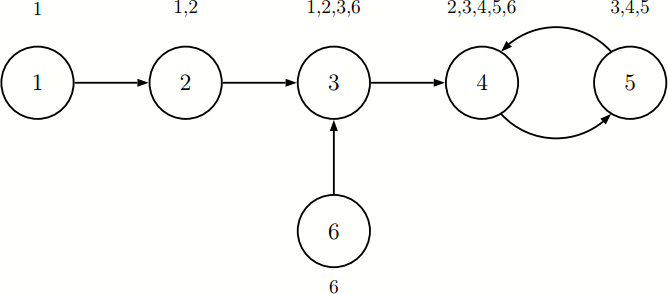P6258 [ICPC 2019 WF] Hobson's Trains
题目背景
### Warning: If you submit a malicious program, you will be banned.
### 警告:恶意提交本题将被封号。
题目描述
Hobson 先生从管理马厩的工作中退休后,投资于一种更加现代的交通方式:火车。
他已经修建了一个包含 $n$ 个火车站的铁路网。然而,他兑现了让乘客摆脱选择困难症的承诺:对于每个站点,乘客只能乘坐火车前往一个站点,别无其它选择。
这样的一段旅程被称作一趟。要注意这是单向的旅程,可能无法再回到出发点。
Hobson 同样也只提供一种车票,允许乘客一次旅行的距离不超过 $k$ 趟。在每个站点的出口会有一个自动读票机(只有一个,所以乘客就不用纠结于要用哪个)。机器会检查从始发站到到达站的距离是否不超过 $k$ 趟。
每个读票机必须编入一个合法始发站列表,但是列表消耗的存储空间越多,机器就越贵。
请帮助 Hobson 先生确定:对于每个站点 $A$,能够在最多 $k$ 趟的旅程中到达 $A$ 的站点个数(包含 $A$ 本身)。

上图为样例输入 1 对应的示意图。每个圆圈代表了一个站点,圆圈旁边的数字为当 $k=2$ 时需要编入读票机的站点编号。
输入格式
第一行包含两个整数 $n, k$,$n$ 为站点个数,$k$ 为一张票允许旅行的最多趟数。
接下来 $n$ 行,第 $i$ 行包含一个整数 $d_i$,表示第 $i$ 个站点经过一趟到达的站点。
输出格式
输出 $n$ 行,第 $i$ 行输出能在 $k$ 趟内到达站点 $i$ 的站点数目。
**【译者注】**
在不侵犯原题版权的情况下,本题面中文翻译基于[知识共享署名-非商业性使用-相同方式共享 4.0 国际许可协议](http://creativecommons.org/licenses/by-nc-sa/4.0/)发布,注明出处时需指向本题链接。
Translate By @小粉兔
说明/提示
对于全部数据,满足 $2\le n\le 5 \times 10^5,1\le k\le n - 1$,对于任意 $1 \le i \le n$ 都满足 $1 \le d_i \le n$ 且 $d_i\ne i$。